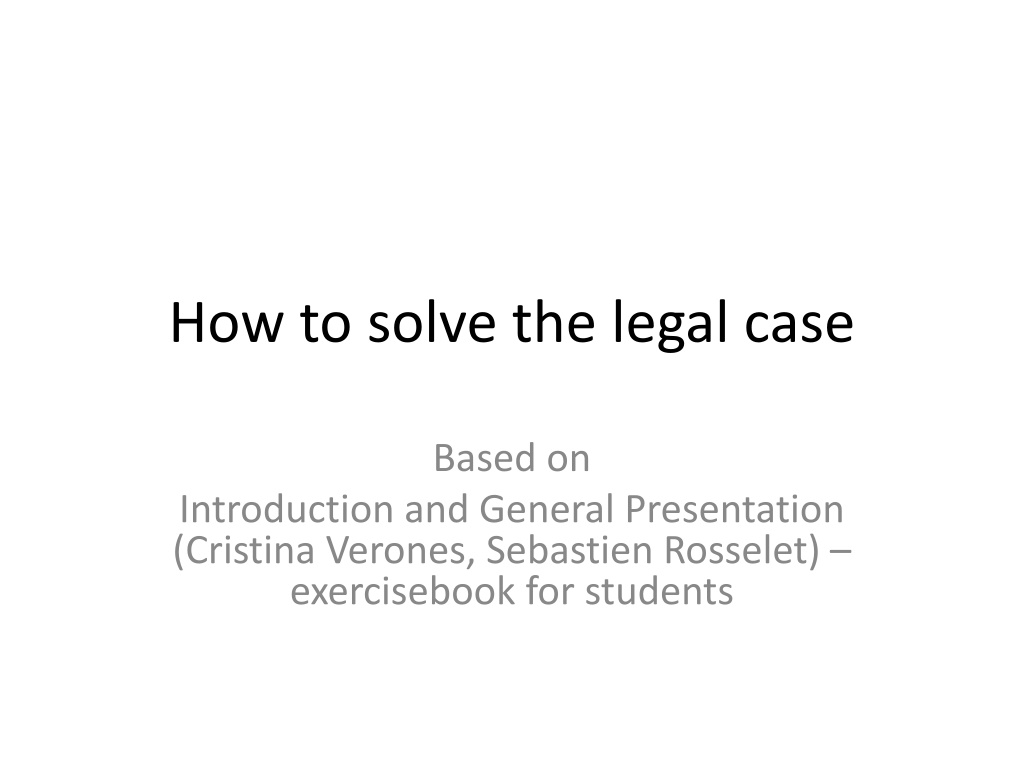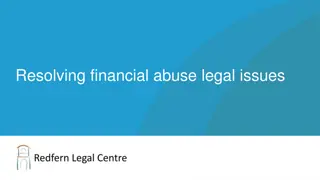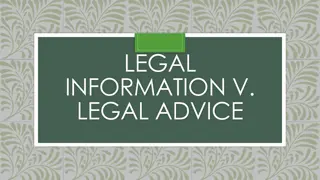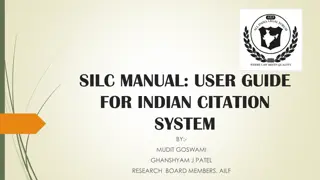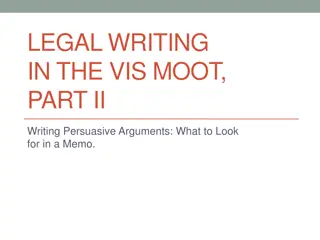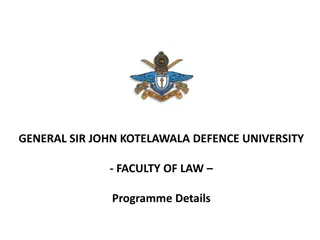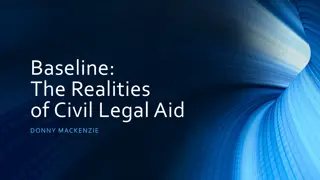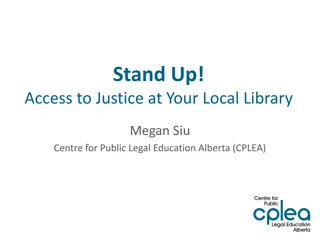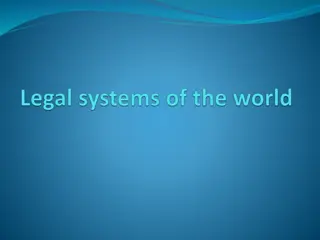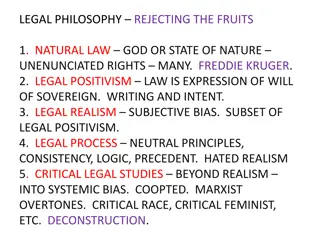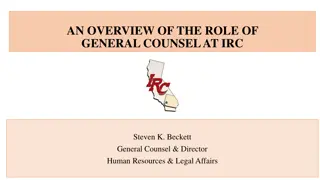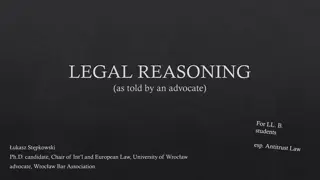Guide to Crafting a Legal Solution: Introduction and General Presentation
Be sure to carefully read the entire legal case, identify relevant legal issues, create a plan for structuring your solution, cite applicable laws, apply those laws to the case facts with reasoning, and conclude on all issues sequentially. Following these steps will help you effectively solve legal cases.
Download Presentation

Please find below an Image/Link to download the presentation.
The content on the website is provided AS IS for your information and personal use only. It may not be sold, licensed, or shared on other websites without obtaining consent from the author. Download presentation by click this link. If you encounter any issues during the download, it is possible that the publisher has removed the file from their server.
E N D
Presentation Transcript
How to solve the legal case Based on Introduction and General Presentation (Cristina Verones, Sebastien Rosselet) exercisebook for students
General remarks AT THE BEGINNING, IT IS IMPORTANT TO READ THE WHOLE CASE (INCLUDING ANY NOTA BENE PARTS AT THE END) CAREFULLY.
General remarks Afterwards, the legal problems and issues have to be identified in order to structure your legal arguments. The questions asked at the end of each case will help you determine the relevant legal problems to be dealt with in this case. It is important to stress here that you should only answer the question asked, regardless of the fact that other legal issues might be present in the case as well.
General remarks It is highly advisable to make a plan of your solution of the case. This allows you to verify if the structure of the solution is logical and correct and if you have forgottenany elements. Once the plan has been made, the writing stage starts.
General remarks First of all, you should identify the relevant legal issue or issues in the case. For example, is there a problem in relation to a treaty, or is the issue rather use of force? You should not simply rewrite the entire case, but determine the legal issues that need to be solved in function of the questions asked.
General remarks Once you have identified the issues that need to be determined, you have to set out the law that is applicable specifically to your issues. It is necessary to cite and explain the relevant law .
General remarks Afterwards, you have to apply the law to the facts of your case. This is the reasoning part of your solution and you should clearly indicate why, or why not, you consider that this rule is applicable to this situation. It is essential to find evidence in the facts of the case to support all of your conclusions.
General remarks Finally, never forget to conclude on all the issues, even if this means writing several intermediary conclusions (after each issue)!!!
The following is a schema proposed for the successful resolution of cases: Question asked: 1. Applicable law in general (eg Vienna Convention on the Law of Treaties) 2. Issue 1 (eg invalidity of the treaty on basis of Article 46 VCLT) (a) set out the relevant legal facts for issue 1 (b) set out, explain and develop the applicable law to issue 1, where necessary complemented with case law and academic writing (c) application of the law of issue 1 to the facts of issue 1 (d) conclusion of issue 1 3. Issue 2 (eg termination of the treaty based on Article 60 VCLT) (a) set out the relevant legal facts for issue 2 (b) set out, explain and develop the applicable law to issue 2, where necessary complemented with case law and academic writing (c) application of the law of issue 2 to the facts of issue 2 (d) conclusion of issue 2 4. Issue x Etc 5. General conclusion on the question asked
IMPORTANT It should be pointed out that one question often raises several different issues. Sometimes, depending on the subject, it is necessary first to solve some preliminary questions before continuing with the analysis. For example, for the question whether or not the use of self-defence was legitimate or not, it has first to be analysed whether the conditions underlying the exercise of self-defence are fulfilled.
IMPORTANT In these cases where there are several issues to be solved for one question, it is important to structure your answer well and to separate the different problems. Your reader has to be able to follow your reasoning as well as possible. Thus, also the order in which you deal with the different issues should be logic and coherent.
Some advice on how to deal with practical cases (schema) How to start with a practical case Legal syllogism when many conditions have to be examined Answer the question asked Arguments invoked by the parties Chronology of events Argumentation
How to start with a practical case When you start with a practical case, read it carefully and in its entirety for a first time and also have a close look at the questions asked. Afterwards, read the case a second time, in order to identify the relevant (legal) facts that you need to solve the legal questions asked.
Legal syllogism when many conditions have to be examined Practical cases, and especially interconnected cases, often contain a large number of relevant facts and conditions to be examined. Such a complex structure can lead to the situation where certain conditions are forgotten and are not dealt with in the application of the law to the facts. When there are many conditions to be analysed, it is advisable to use the general plan for each specific issue and not to mix the analysis of different conditions. It will thus also be easier for the reader to follow your reasoning and to avoid errors and to forget certain conditions.
For example: when dealing with legitimate self- defence under Article 51 of the United Nations Charter, a series of conditions have to be dealt with; each condition needs to be accompanied by a development and analysis of the relevant law. Thus, instead of writing one long paragraph and mixing the different conditions, it is advisablem to deal with each condition one after the other. So, in our example, start by developing the notion of armed attack. Then, apply the relevant law in relation to this condition to the facts of your case. After that, make a conclusion on this condition of the occurrence of an armed attack. Proceed to the following conditions, one by one.
Answer the question asked It is indispensable to reply to the question asked in the case. Not doing so, but also going beyond what the question asked, will not satisfy the requirements. Therefore, there needs to be a certain parallel between the question and the conclusion, including all the issues that have been identified. In fact, this parallel is easy to verify, since it is enough to take your conclusion and confront it to the question asked. If your conclusion is an answer to the question, then the parallel is respected.
Arguments invoked by the parties The facts of the cases often mention the different arguments made by the different parties in the case in support of their position or in questioning the others position. These arguments are frequently crucial and offer lines of reasoning or issues to be dealt with in your solution. Furthermore, often one of the arguments is well founded and will thus indicate important elements for your answer. It is therefore sensible to address the different arguments made by the parties well, since they can serve as a guide in your solution.
Chronology of events The potential problem of the chronology of events usually occurs in the interconnected cases. If you have time, it is often useful to write down the different events in chronological order on a time line. This allows you to visualise better the chain of events, which can be important when the order of the different actions is crucial for the analysis of one question.
Argumentation It is often not necessary to make very big and complicated arguments. It is preferable to write and argue in a clear and concise style. This method will give your argumentation more force and will demonstrate your facility with the matter. It is also useful to keep in mind that the cases have often been written with a solution in mind. Thus, in general, the difficulty lies rather with the identification of the relevant legal facts for a particular argument, than with the way of arguing as such. This rule applies, of course, only to cases which have been written for exercising and teaching purposes. The reality is very different.
Schema Facts (better in chronological order) 1 .. 2 .. 3 .. 4 .. 5 .. Questions (general and detailed) 1 . 2 . 3 . 4 . 5 .
Analysis What are the facts? What law is applicable? What problems we have ? main and detailed problems Process of subsumption Explanation (reasons) Conclusions Justification
Answer Solution of the problem
Justification Giving reasons of the answer
